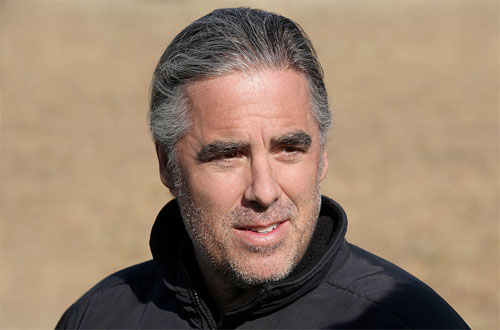Gregory Colbert (born 1960 in Toronto) is a Canadian film-maker and photographer best known as the creator of Ashes and Snow, an exhibition of photographic artworks and films housed in the Nomadic Museum. Colbert sees himself as an apprentice to nature. His works are collaborations between humans and other species that express the poetic sensibilities and imaginations of human and animals. His images offer an inclusive non-hierarchical vision of the natural world, one that depicts an interdependence and symmetry between humanity and the rest of life. In describing his vision, Colbert has said,
"I would define what I do as storytelling... what’s interesting is to have an expression in an orchestra—and I’m just one musician in the orchestra. Unfortunately, as a species we’ve turned our back to the orchestra. I’m all about opening up the orchestra, not just to other humans, but to other species."
Colbert began his career in Paris in 1983 making documentary films on social issues. Film-making led to fine arts photography. Colbert's first exhibition, Timewaves, opened in 1992 at the Museum of Elysée in Switzerland to wide critical acclaim. For the next ten years, Colbert did not publicly exhibit his art or show any films. Instead, he traveled to such places as Antarctica, India, Egypt, Burma, Tonga, Australia, Malaysia, Sri Lanka, Namibia, Kenya, Tanzania, Thailand, China, the Arctic, the Azores, and Borneo. Elephants, whales, manatees, sacred ibis, cranes, eagles, gyrfalcons, Rhinoceros Hornbills, cheetahs, leopards, African wild dogs (Lycaon pictus), caracals, baboons, eland, meerkats, gibbons, orangutans, penguins, pandas, polar bears, lions, giant Pacific manta rays, and saltwater crocodiles are among the animals he has filmed and photographed.
Human collaborators include San bushmen, Tsaatan, Lisu, Massai, Chong, Kazakhs, and people from other indigenous tribes around the world. Colbert, who calls animals "nature's living masterpieces," photographs and films both wild animals and those that have been habituated to human contact in their native environments. The images record what he saw through the lens of his camera without the use of digital collaging.
Source: Wikipedia
Photographer/filmmaker Gregory Colbert is the creator of the exhibition Ashes and Snow, an immersive experience of nature that combines photographic artworks, films, and soundscapes, housed in a purpose-built traveling structure called the Nomadic Museum. To date, Ashes and Snow has attracted over 10 million visitors, making it the most attended exhibition by any living artist in history.
Colbert was born in Toronto, Canada, in 1960. He began his career in Paris in 1983 making documentary films on social issues. His first exhibition, Timewaves, opened to wide critical acclaim in 1992 at the Museum of Elysée in Switzerland. For the next ten years, Colbert went off the grid and did not publicly share his art or show any films. He began traveling the world to photograph and film wondrous interactions between animals and humans.
After ten years passed, Colbert returned to present Ashes and Snow at the Arsenale in Venice, Italy, in 2002. With his debut, Photo magazine declared,
"A new master is born." The New York Times, in an article by Alan Riding, stated,
"The power of the images comes less from their formal beauty than from the way they envelop the viewer in their mood... They are simply windows to a world in which silence and patience govern time." Ashes and Snow has been described as "extraordinary" by the Economist, and "distinctive... monumental in every sense" by the Wall Street Journal. Stern magazine described the photographs as "fascinating," and Vanity Fair named Gregory Colbert in its "Best of the Best."
Source: gregorycolbert.com
